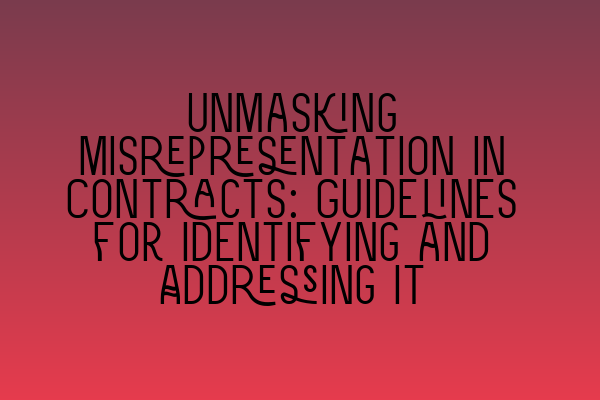Unmasking Misrepresentation in Contracts: Guidelines for Identifying and Addressing It
Misrepresentation in contracts can lead to serious legal consequences, impacting both parties involved. As a solicitor, it is crucial to have a deep understanding of misrepresentation and the ability to identify and address it effectively. In this article, we will explore the concept of misrepresentation, its different forms, and provide guidelines to help you navigate this legal challenge. We will also discuss the importance of upholding professionalism and ethical responsibilities in your practice when dealing with misrepresentation.
What is Misrepresentation?
Misrepresentation occurs when one party makes a false statement or representation that induces another party to enter into a contract. It is a fundamental principle of contract law that parties should enter into contracts based on accurate and truthful information. Misrepresentation undermines this principle and can result in contracts being voidable or open to legal challenges.
Forms of Misrepresentation
Misrepresentation can take different forms, each with its own implications. It is essential to be aware of these forms in order to identify potential misrepresentations in contracts:
1. Innocent Misrepresentation:
In innocent misrepresentation, the party making the false statement genuinely believes it to be true and has no intention to deceive. Although innocent misrepresentation does not involve fraudulent intent, it can still render a contract voidable. It is important to assess the impact of innocent misrepresentation on the overall validity of a contract.
2. Negligent Misrepresentation:
Negligent misrepresentation occurs when a party makes a false statement without exercising reasonable care or skill in verifying its accuracy. Unlike innocent misrepresentation, negligent misrepresentation can result in liability for the party making the false statement. As a solicitor, it is crucial to investigate and gather evidence of negligence if you suspect negligent misrepresentation in a contract.
3. Fraudulent Misrepresentation:
Fraudulent misrepresentation involves making a false statement with the intention of deceiving the other party. It is a serious offense and can lead to criminal charges, as well as civil liability. If you suspect fraudulent misrepresentation, it is essential to gather evidence and seek legal remedies to protect your client’s interests.
Identifying Misrepresentation
Identifying misrepresentation in contracts requires a thorough examination of the facts and statements made. Here are some guidelines to help you identify potential misrepresentations:
1. Review the Contract:
Carefully review the contract and identify any statements or representations made by the parties. Compare these statements with the actual facts and evidence available. Look for discrepancies that could indicate misrepresentation.
2. Obtain Documentation:
Collect all relevant documentation and evidence that can support or disprove the statements made in the contract. This may include emails, letters, reports, or any other form of communication or evidence that sheds light on the truthfulness of the statements.
3. Conduct Witness Interviews:
Interview witnesses who may have knowledge or information about the statements made in the contract. Their perspective can be valuable in determining the veracity of the statements and identifying any misrepresentation.
4. Seek Expert Advice:
If necessary, seek expert advice from specialists in relevant fields to assess the accuracy of the statements made in the contract. Their professional opinion can provide valuable insights and strengthen your case.
Addressing Misrepresentation
Once misrepresentation is identified, it is crucial to take appropriate actions to address this issue. Here is a step-by-step guide to handling misrepresentation:
1. Notify Client:
Inform your client about the potential misrepresentation and the implications it may have on the contract and their rights. Provide them with a clear understanding of the situation and discuss the available options.
2. Gather Evidence:
Collect all necessary evidence that supports your claim of misrepresentation. This may include documents, records, witness statements, or expert opinions. Ensure that the evidence is well-documented and organized for legal proceedings.
3. Communicate with the Other Party:
Engage in open and transparent communication with the other party to address the issue of misrepresentation. This may involve negotiations, mediation, or other forms of dispute resolution. Seek legal advice on the best approach to resolving the issue effectively.
4. Consider Legal Remedies:
If the other party refuses to acknowledge or address the misrepresentation, you may need to consider legal remedies. This could involve filing a lawsuit, seeking damages, or requesting the court to void the contract. Consult with your client and explore the available legal options.
Understanding the legal challenges and pitfalls in your practice is essential for maintaining professionalism and upholding ethical responsibilities. Check out the following related articles:
Navigating Legal Challenges and Pitfalls in Your Practice
This article provides insights into various legal challenges and pitfalls that solicitors may encounter in their practice. It offers strategies and guidance to overcome these challenges and uphold professional standards.
Ethical Responsibilities of Solicitors: Upholding Professionalism
Professionalism and ethical responsibilities are integral to the practice of law. This article explores the ethical obligations that solicitors have and provides tips on how to maintain professionalism in your legal career.
Barrister vs. Solicitor: A Comprehensive Comparison
If you are considering a career as a solicitor, this article offers a detailed comparison between barristers and solicitors. It discusses the roles, responsibilities, and differences between the two legal professions.
Understanding the SRA Competence Statement: A Guide for Solicitors
The SRA Competence Statement outlines the skills and knowledge expected from solicitors. This article provides a comprehensive guide to understanding and meeting the SRA requirements for professional competence.
Networking for Solicitors: Strategies for Building a Strong Network
Networking is essential for solicitors to build connections, obtain referrals, and expand their professional reach. This article offers strategies and tips for solicitors to develop a strong and effective network.
By familiarizing yourself with these related articles, you can further enhance your legal knowledge and professional skills, ensuring that you are well-equipped to navigate the challenges of misrepresentation and other legal issues in your practice.
